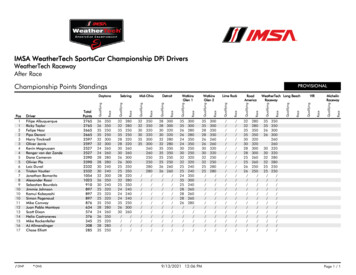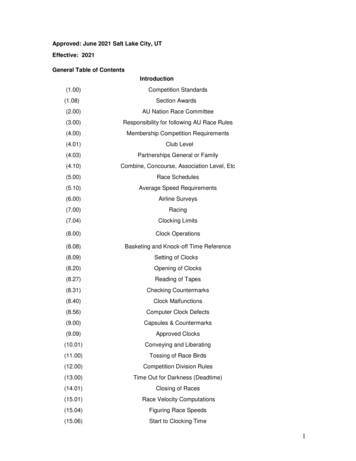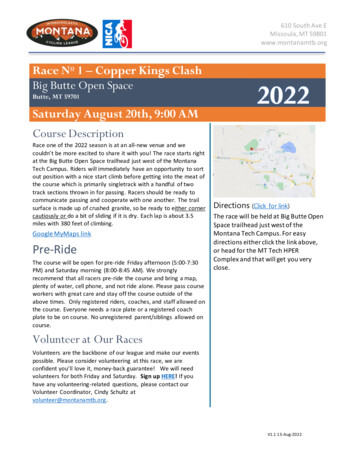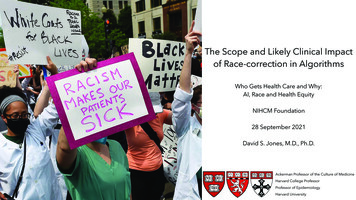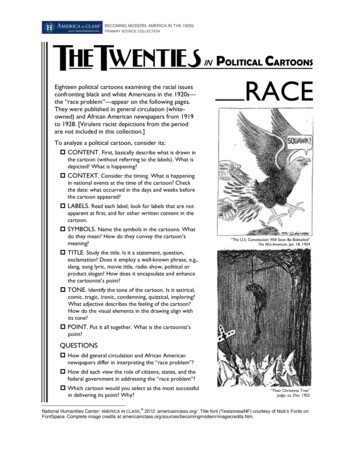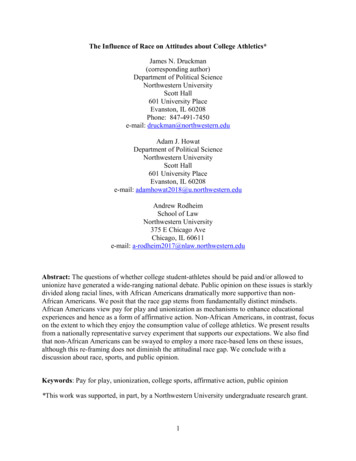
Transcription
The Influence of Race on Attitudes about College Athletics*James N. Druckman(corresponding author)Department of Political ScienceNorthwestern UniversityScott Hall601 University PlaceEvanston, IL 60208Phone: 847-491-7450e-mail: druckman@northwestern.eduAdam J. HowatDepartment of Political ScienceNorthwestern UniversityScott Hall601 University PlaceEvanston, IL 60208e-mail: adamhowat2018@u.northwestern.eduAndrew RodheimSchool of LawNorthwestern University375 E Chicago AveChicago, IL 60611e-mail: a-rodheim2017@nlaw.northwestern.eduAbstract: The questions of whether college student-athletes should be paid and/or allowed tounionize have generated a wide-ranging national debate. Public opinion on these issues is starklydivided along racial lines, with African Americans dramatically more supportive than nonAfrican Americans. We posit that the race gap stems from fundamentally distinct mindsets.African Americans view pay for play and unionization as mechanisms to enhance educationalexperiences and hence as a form of affirmative action. Non-African Americans, in contrast, focuson the extent to which they enjoy the consumption value of college athletics. We present resultsfrom a nationally representative survey experiment that supports our expectations. We also findthat non-African Americans can be swayed to employ a more race-based lens on these issues,although this re-framing does not diminish the attitudinal race gap. We conclude with adiscussion about race, sports, and public opinion.Keywords: Pay for play, unionization, college sports, affirmative action, public opinion*This work was supported, in part, by a Northwestern University undergraduate research grant.1
Should college athletes be paid, i.e., “pay for play?” Should they be allowed to unionize,ensuring universities treat them as employees rather than students? These questions havegenerated a vigorous national debate about the role and rights of student-athletes.1 While theNational Collegiate Athletic Association (NCAA) recently expanded financial benefits forstudent-athletes, it continues to staunchly oppose extensive pay for play and unionization(Auerbach 2014: 3; also see Armour 2013; Tarm 2014; Trahan 2014). This coheres with the fanbase: public opinion polls show that only about 33% support paying college athletes and only47% favor of unionization (Prewitt 2014).2 Underlying these numbers, however, is a perplexingracial divide such that non-whites exhibit substantially more support (with 51% supporting payfor play and 66% supporting unionization) (Prewitt 2014; also see Mondello et al. 2014).What explains this racial divide? What role do racial considerations play in opinionformation processes about these issues? We address these questions by beginning with adiscussion of public opinion on affirmative action and related policies – particularly focusing onthe racial divide in opinions. We then describe extant research on the role of race in collegeathletics. We explain that one of the purported aims of athletic scholarships is to ensure studentsreceive adequate educational opportunities; yet, there are rising concerns that many of thesestudents have not, in fact, received adequate educational support and/or “fair compensation”from their institutions. We further argue that African Americans view pay for play andunionization as a mechanism for enhancing affirmative action (i.e., these policies would ensurestudent-athletes have the necessary resources to have a positive educational experience). Incontrast, non-African Americans do not view the issues through the lens of race but rather focuson the extent to which they enjoy the consumption value of college athletics. While a re-framingof the issues can sway non-African Americans to alter the basis of their opinions, it does not2
reduce racial divisions. We provide supportive data from a nationally representative surveyexperiment and conclude with a discussion of race, education, and public opinion.Affirmative Action and the Racial Opinion GapAffirmative action in the United States typically involves active efforts to improveemployment or educational opportunities for members of minority groups and/or women.3 Overtime, public support for affirmative action in the United States has polarized along racial lines,with African Americans significantly more supportive than whites (Steeh and Krysan 1996). Forexample, a Pew Research Center poll reported that 22% of white respondents agreed that “weshould make every effort to improve the position of blacks and minorities ,” compared to 58%of African-Americans who agreed (Pew Research Center 2009). While support overall riseswhen it comes to education, the racial gap remains with 55% of whites and 84% of AfricanAmericans agreeing that “affirmative action programs designed to increase the number of blackand minority students on college campuses are a good thing” (Pew Research Center 2014; alsosee Downing et al. 2002). Altbach, Lomotey, and Rivers (2012) provide some insight into thegap by explaining that universities are commonly viewed as key meritocratic “sorting”institutions, and that despite the prevalence of racially liberal attitudes on college campuses,there remain undercurrents of resentment toward affirmative action and similar programs.Largely beginning with renewed controversy over affirmative action in the late 1990s, theuse of race as a criterion in college admissions has declined. Several state university systemshave eliminated affirmative action altogether from their admissions processes (Long 2004). Suchdecisions typically have led to a substantially reduced minority population in those schools’student bodies (Espenshade and Radford 2009), despite some states’ efforts to make up thedifference through alternative policies – e.g., by guaranteeing admission to a certain top3
percentage of each high school’s graduating class (Long 2004). Debates over affirmative actionin higher education have continued into the present, leading, among other things, to some recentand prominent court challenges. Results in these cases have been mixed: for example, anappellate court in Texas ruled that the University of Texas at Austin could continue to use race inadmission decisions (Greenblatt 2014).4 Yet around the same time, the United States SupremeCourt upheld a Michigan constitutional amendment banning the use of affirmative action inadmissions (Liptak 2014).Even where racial considerations in admission are explicitly banned, however, thereremains a loophole of sorts in the form of “special admission.” As Sperber (1995) explains,special admission enables institutions to consider “special talents” in areas such as music andathletics when choosing which applicants to admit – and African American athletes comprise asignificant portion of students recruited on such a basis. Sperber (1995) further notes that evenfervent opponents of race as an admission criterion seldom express opposition to such specialactions. For us, the relevant question is whether these exceptions for athletic “special talents,”and potential enhancements in the scholarships that come with them, are in fact viewed as a typeof affirmative action. In other words, are the supplementing of extant scholarships withadditional money (pay for play) and the right to unionize viewed as extending affirmative action?And if not, is it possible to re-frame these additions to athletic scholarships in such terms?Athletic Scholarships and Affirmative ActionAs explained, debates concerning the criteria used for college admissions are wideranging, and one of the most heated points of disagreement concerns the consideration of anapplicant’s race. Since race is often not a viable explicit criterion (see above discussion), manysupporters of affirmative action in education focus on other admission criteria – particularly the4
above-mentioned “special talents” – that correlate with minority status. Of particular note is thepossibility of using athletic scholarships as a mechanism for affirmative action among AfricanAmericans. For example, in her dissent of the Supreme Court’s aforementioned decision touphold a Michigan ban on affirmative action for public universities, Justice Sonia Sotomayorcited athletics, inter alia, as a criterion that can be used in admission decisions f).The idea that athletic scholarships serve as a form of affirmative action tracks “thegenerally held view [that] the beneficiaries of affirmative action athletic scholarships are mainlyAfrican Americans” (Fobanjong 2001: 128; also see Dolinsky 2001). Relative to their proportionin colleges, African Americans receive a disproportionate number of athletic scholarships. Forexample, in 2007-8, African Americans received nearly 23% of athletic scholarships but theymade up about 12% of the student population (Kantrowitz 2011). No other racial/ethnic grouphad its percentage of athletic scholarships exceed its percentage among the student bodies.Indeed, “college sports are often heralded as vehicles for racial integration and social mobility.Successful integration and mobility are thought to be achieved by providing educationalopportunities to a diverse group of students, many of whom might be unable to attend collegewere it not for their athletic abilities and corresponding sports scholarships” (Van Rheenen 2013:551). Thus, while African Americans would not constitute the majority of the beneficiaries ofexpanded aid for college athletes, they may well be perceived as the most important potentialrecipients: “college sports persistently disadvantage Black male student-athletes conferencesshould commit a portion of proceeds earned from championships and other revenue sources backto member institutions for programing and other interventions that aim to improve racial equitywithin and beyond sports” (Harper et al. 2013: 1, 16; also see Funk 1991). The key point is that,5
even though the majority of athletic scholarship recipients are not African Americans, athleticscholarships still disproportionally tend to benefit African Americans. This is particularly true inthe revenue-generating sports of men’s basketball and football, where data from 76 institutionsand six athletic conferences suggest that between “2007 and 2010, Black men were 2.8% of fulltime, degree-seeking undergraduate students, but 57.1% of football teams and 64.3% ofbasketball teams” (Harper et al. 2013: 1).5Even if athletic scholarships serve as mechanism for affirmative action, are theysufficient (historically covering the cost of tuition, fees, textbooks, and room and board; we laterreturn to recent reforms that enhance scholarships – a development that occurred after our datacollection)? While athletic scholarships include such supports as tutoring, for many, scholarshipson their own provide insufficient resources to ensure a good education. Hawkins (2010) statesthat even top university athletic programs often recruit students, including a large number ofAfrican Americans, who lack the skills or preparation to succeed at the college level, and thatmany institutions thereafter take relatively little initiative to help these student-athletes throughtheir academic struggles. Benson (2000) asserts that the “academic inadequacies” observedamong some African American student-athletes result not just from their own choices but fromthose made by their teachers, coaches, and others within their universities – for example,funneling athletes toward easier classes or failing to impose consequences for poor grades. Alongsimilar lines, interviews with several former student-athletes suggest they feel that they wereinstead treated as “athlete-students” (Beamon 2008: 356), with academics treated mainly as ameans to maintain athletic eligibility. Such institutional practices may diminish or even eliminatethe purported downstream benefits of attending elite universities, as Loury and Garman (1993)6
find – perhaps unsurprisingly – that the impact of attending a selective college on future earningsis moderated by a student’s actual academic performance.This is in line with a general argument that, when it comes particularly to the revenuegenerating men’s basketball and football (see note 1), student-athletes are exploited given theschools’ profits relative to the often insufficient educational opportunities provided (Beamon2008; Benson 2000; Hawkins 2010; Sperber 1995; Van Rheenen 2013). Such a dynamic callsinto question the degree to which these scholarships truly provide students with the enhancededucational opportunities they need. “[I]f an educational opportunity is unlikely to be realizedbased upon structural constraints and conflicts, or even with genuine effort expended on the partof the college athlete, the relationship is indeed exploitive” (Van Rheenen 2013: 564; italicsadded).This pattern of institutional exploitation also closely intertwines with issues of race. In astudy of 581 Division 1 athletes, Van Rheenen (2011) finds the subjective feeling of beingexploited, similar to that described by Beamon (2008), to be far more common and pronouncedamong African Americans. Hawkins (2010) further argues that this sort of exploitation is notmerely economic, but a manifestation of broader socio-political trends of racism anddiscrimination: the valuing of African Americans more as athletes than as students, he suggests,arises naturally from historical patterns of commodification and dehumanization (also see Allen2004). From such a perspective, it becomes quite easy to view expanded benefits for collegeathletes as a means toward remedying persistent and pervasive racial inequalities.There also is the basic issue of whether scholarships provide the economic means neededto live and excel in college, given that Division 1 scholarships, at the time of our study, coveredsome items (e.g., tuition, university fees, required textbooks, room and board) but not others7
(e.g., parking permits, student identification cards, course fees, library fines, graduate fees). OneNCAA student-athlete explains, “[t]he average full scholarship, which pays for tuition, housing,and food isn’t enough to cover inevitable, out-of-pocket expenses that a normal collegestudent has the average Division 1 athlete actually dedicates about 40 hours a week to athleticendeavors [which makes it] impossible for a student-athlete to [have a job] Providingmonetary compensation sufficient to cover expenses would allow student athletes to continueto compete at the college level while also completing a meaningful, not token education”(Anonymous 2014: 9-10; also see Beamon 2008). Approximately 85% of scholarship studentathletes live below the federal poverty line, leading to decreased graduation rates (Nance-Nash2011; also see Huma and Staurowsky 2011) which in turn belie the “promise of an education inexchange for athletic performance” (Van Rheenen 2013: 563).The take-away of this discussion is three-fold. First, the key beneficiaries of athleticscholarships, particularly when it comes to the revenue-generating sports of men’s basketball andfootball, are often seen to be African Americans, and in this sense, athletic scholarships can beconstrued as a form of affirmative action – the scholarships help African-Americans pursueeducational opportunities. Second, even if seen as a form of affirmative action, to many, athleticscholarships do not provide sufficient supports to ensure a good education and resources to covercost of living. This raises issues of exploitation of student-athletes by their institutions and thebasic lack of economic resources to cover costs and ensure one lives above the poverty line.Third, in light of the prior two points, enhanced benefits added to the scholarship can be seen asextended affirmative action, aimed at vitiating such exploitation and ensuring sufficientresources for African Americans.8
In the domain of athletic scholarships, two prominent proposals include pay for play andunionization. Pay for play would allow student-athletes to receive pay – akin to salaries – beyondtheir existing scholarships. This could help student athletes achieve relatively better materialcomfort that could facilitate educational success, and it would, at least partially, address theaforementioned exploitation due to some revenue redistribution. Unionization would ensurecollective bargaining rights (by viewing student-athletes as employees) that could generateprotections as well as additional finances (stipends) and benefits (e.g., medical) that wouldpromote long-term educational success (i.e., it would make universities more responsible forstudent-athletes’ long-term well-being; see Druckman et al. 2014).Consequently, both pay for play and unionization can be viewed as part of an affirmativeaction initiative “designed to help blacks and other minorities get better jobs and education (e.g.,a college education)” (Pew Research Center 2009). The policies do so, in part, to compensate forunequal opportunities/discrimination/exploitation. Consequently, if an individual views pay forplay and unionization as part of extended affirmative action programs, then the more he/shesupports affirmative action, the more he/she will support pay for play and unionization.Individuals are more likely to view pay for play and unionization in this light when theytake the perspective of the main beneficiaries, who, given relative proportions, are AfricanAmericans. The theory of linked fate argues that there is an “acute sense of awareness (orrecognition) that what happens to the group will also affect the individual member” (Simien2005: 529; also see, e.g., Gay and Tate 1998; Herring et al. 1999). The implication is thatAfrican Americans will focus on the beneficiaries since they are part of the same group, leadingthem to think in terms of the accrued affirmative action benefits.6 In addition to linked fate,African Americans are more likely to take the perspective of affirmative action due to their9
historical experiences. Blackstone (cited in Putterman 2014: 1) states, “Black folks much moreeasily identify with the majority of athletes They have more emotional understanding, politicalunderstanding of the mechanisms of college athletics.” Similarly, sociologist Aldon Morrisexplains that whites will more likely sympathize with the managerial interests like theUniversity, while African-Americans will relate to the working-class perspective of the studentathletes. He continues that for whites, thinking of “athletes as workers, as employees goesagainst their view of the benign, embracing culture of their university. ” (Putterman 2014: 1).Thus, we predict that African Americans will be significantly more likely, than others, to viewpay for play and unionization as a type of affirmative action and their opinions on the issues willreflect their affirmative action views.Instead of viewing the issues through the lens of affirmative action, non-AfricanAmericans will think more about the overall product: college sports. If they value that product –that is, they are fans – they will be more likely to support the NCAA perspective. As NCAAPresident Mark Emmert explains, “one of the biggest reasons fans like college sports is that theybelieve the athletes are really students who play for a love of the sport To convert collegesports into professional sports would [lead to a product that is not] successful either for fansupport or for the fan experience” (Dahlberg 2014: 1).7 He further states that “No, it will nothappen – not while I’m president of the NCAA” (cited in Mondello et al. 2014: 109). In short,pay for play and unionization would have potentially deleterious effects on the product, whichmost non-African Americans perceive. Thus, the more such individuals care about the product,the more they oppose the policies. We predict that for non-African Americans, support for payfor play and unionization will decrease as being a fan increases.Framing10
A large literature suggests that individuals’ opinions shift when presented with a reframing of an issue. For example, the presentation of welfare provisions as promoting equalitycauses people to support increased welfare benefits. When welfare is instead described in termsof increased taxes, support declines (Sniderman and Theriault 2004; for a review, see Klar et al.2013). Lewis and Weaver (2013: 1) explain, “Sports journalists can and do employ variousframes that emphasize specific content in their stories; but the influence these frames have onsubsequent audience evaluations pertaining to athletes features within them is unknown.” Asidefrom these authors, scant research has explored the impact of frames on sports attitudes. In recenttimes, common frames have evolved from those emphasizing game statistics and performance(e.g., Nixon 2014) to a greater focus on individual players and their stories/struggles (Lewis andWeaver 2013).Given our focus, we are interested in identifying a frame that increases the likelihood thatindividuals view pay for play and unionization through an affirmative action lens. Past worksuggests four critical elements to such a frame. First, the frame needs to connect pay for play andunionization to race since affirmative action programs are meant to help African Americans andother minorities obtain better jobs and education. Second, the frame needs to make clear howthe programs will help to ensure improved educational experiences (e.g., the programs are then aform of affirmative action). Third, in the domain of race and affirmative action, past worksuggests a particularly effective frame focuses on remedial action: “supporters of affirmativeaction have typically defended their position by reference to the need for remedial action.Under this frame, race-conscious programs are required to offset the continuing perniciouseffects of racial discrimination” (Kinder and Sanders 1996: 175; italics in original). When theissue is framed this way, support for affirmative action tends to increase (Kinder and Sanders11
1996). This applies in our case, in some sense, although the current status of student-athletes isbetter characterized a case of exploitation (as explained) than discrimination per se. Thus, theremedial action here is about offsetting the effects of racially relevant exploitation (e.g., schoolsreceive much revenue from basketball/football without providing adequate resources and/oreducational opportunities to the student-athletes).8 Fourth, affirmative action is linked mostly toimproved opportunities rather than outcomes: indeed, support for policies increases when theyare described in terms of “opportunity enhancement,” as opposed to striving for equal outcomesfor all members of disadvantaged groups (Bobo 1998; Krysan 2000).Thus, an effective frame would make the racial element clear, suggest that pay for playand unionization would enhance educational experiences, portray the policy as way to addresspast discrimination (or, in our case, exploitation), and focus on resources needed to fully benefitfrom the opportunity for educational success. These elements, taken together, would prime anaffirmative action perspective and therefore lead to increased support concomitant with increasedsupport for affirmative action.We predict that exposure to an affirmative action/exploitation frame (as just described)will increase the salience of affirmative action in the formation of pay for play and unionizationattitudes. This is relevant particularly for non-African American individuals, as we expectaffirmative action considerations to matter even sans a frame for African American individuals.In this way, our research expands the concept of framing to a novel policy domain while drawingupon a large body of literature on race, inequality, and remedial policies. We expect AfricanAmericans to exhibit substantially more overall support for pay for play and unionization –consistent with the aforementioned polls. This follows since African Americans base theiropinions on affirmative action considerations, and nearly unanimously support programs when12
they are explicitly tied to jobs and education (Pew Research Center 2009, 2014). In contrast,non-African Americans will inevitably be more variable – with a lower overall mean – in theextent to which they are “fans of college sports,” and since this will drive overall support, suchsupport will be lower. Even when re-framed to an affirmative action perspective, non-AfricanAmericans will still be less supportive since their support of affirmative action is relativelylower: between 55% and 70% are supportive (Pew Research Center 2009, 2014). Thus, the racialgap in overall support will not disappear with a re-framing.9Survey ExperimentWe tested our hypotheses with an experiment embedded in a nationally representativesurvey in the United States (implemented over the Internet) with a total of 1,555 participants.The data were collected from July 23rd to July 30th, 2014, which preceded reforms (discussedbelow) that enable selected NCAA conferences to have increased autonomy in rule-making,allowing for increased student-athlete subsidies.To collect our data, we contracted with the survey vendor . The company implemented our survey via theInternet on a representative sample of the U.S. population. The sample is an opt-in panel thatacquires potential respondents from a wide host of partners (e.g., commercial sponsors). Theyinvite individuals to join the survey panel and compensate them for participation. For eachparticular survey, ResearchNow (2015: 2) employs “a proprietary method of exclusively invitingpre-validated individuals, or individuals who share known characteristics ” In other words,they employ an algorithm based on likely response rates to ensure a sample that closelyresembles (i.e., is representative of) the U.S. population, based on U.S. census figures (seeResearchNow 2015). The company also implements a wide range of data quality validation13
checks, including checking for logical answers, consistent reporting, minimal non-response,realistic response times, etc. (for general discussion of these types of samples, see, e.g.,Callegaro et al. 2014; Gelman and Rothschild 2014).10 For us, this approach to sampling andsurvey design ensures high quality data: a growing body of evidence suggests that opt-in panelsgenerate analogous inferences to probability samples, especially when it comes to experimentalresearch which is a part of our focus (see Berinsky et al. 2012). A critical issue relevant to thegeneralizability of an experimental causal inference concerns the identification of a variable thatmoderates the impact of the treatments (Druckman and Kam 2011). In our case, we have a cleartheory that posits race as such a moderator, thereby facilitating causal inference.There are three key components to our survey experiment. First, our central dependentvariables were questions about support for pay for play and unionization. The former asked,“Recently, a proposal has been made that would allow student-athletes to receive pay – akin tosalaries – beyond their existing scholarships. To what extent do you oppose or support thisproposal?,” with answers on a 7-point fully labeled scale ranging from strongly oppose tostrongly support. The latter asked, “To what extent do you oppose or support efforts to unionizecollege athletics, so that student-athletes can then negotiate (and collectively bargain) about theirworking conditions?,” again with a 7-point fully labeled response scale from strongly oppose tostrongly support. Both wordings resemble those used in prior surveys (e.g., Prewitt 2014;Druckman et al. 2014; Mondello et al. 2014), although unlike some (but not all) previous work,we allowed a wider array of responses rather than simply “yes” or “no.”Second, we measured affirmative action support and the extent to which respondentswere sports fans. For affirmative action, we focused on educational opportunities: “To whatextent do you oppose or support affirmative action programs designed to help blacks and other14
minorities get better jobs and education (e.g., such as a strong college education?)” with answerson a 7-point labeled scale from strongly oppose to strongly support (see Pew Research Center2009). Thus, our measure tracks closely on how we described the potential ways in which payfor play and unionization could facilitate educational experiences. Our college sports fanquestion asked: “On a scale on which a five means you are ‘a very big college sports fan’ and aone means you have ‘absolutely no interest in college sports,’ in general, how big of a collegesports fan are you?” (see http://sports.espn.go.com/espn/otl/news/story?id 5988173). (We askedthese two questions at the start of the survey, and they were followed with a host of unrelatedquestions, prior to our experiment.)We included various independent control variables including self-identified racial andethnic group (which we used to identify African-American respondents), age (on a 6-point scalethat included age ranges), gender, education (on a 5-point scale that gauged highest level ofeducation), income (on a 5-point scale that included income ranges), ideology (on a 7-point scalewith higher scores indicating increased conservatism), and racial prejudice (which merged fourmeasures of racial resentment/symbolic racism used by the American National Election Studies,with higher scores indicating greater prejudice; see, e.g., Kinder and Sanders 1996).Finally, to test our framing prediction, we randomly assigned respondents to one of threeconditions. The control condition asked the aforementioned questions (N 566). Our affirmativeaction/exploitation frame condition (N 496) began with this statement:As you may know, there is an ongoing debate about whether college at
from a nationally representative survey experiment that supports our expectations. We also find that non-African Americans can be swayed to employ a more race-based lens on these issues, although this re-framing does not diminish the attitudinal race gap. We conclude with a discussion about race, sports, and public opinion.


